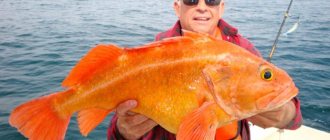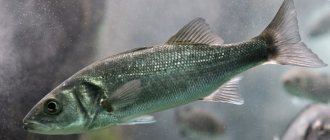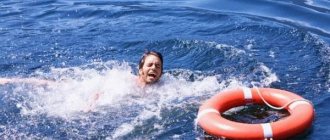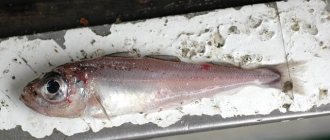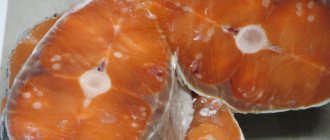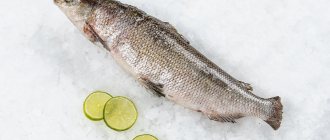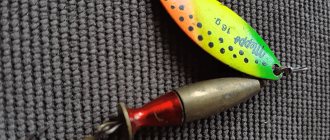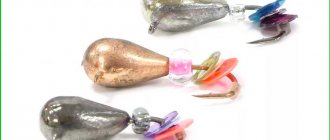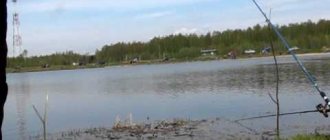Sea bass meat is not only extremely tasty, but also contains a large amount of vitamins and minerals. Some of the perch species are already listed in the Red Book. The size of this fish sometimes reaches one meter, and its weight exceeds 10 kg. Unfortunately, recently cases of infection of marine fish with parasites have become more frequent. Not all of them are harmless to humans. Many of them can cause irreparable damage to health. Parasites in sea bass are represented by various species, among which Diphyllobothrima latum and Iphyllobothrium dendriticum are dangerous.
Sea bass
It has the following characteristics:
- This fish is viviparous. That is, she does not lay eggs, but immediately releases the fry.
- Externally, sea and river perch are very similar.
- It has sharp fins that can cause a lot of trouble to humans. When the skin is damaged after a fin prick, difficult-to-heal, purulent wounds often appear.
- It belongs to the scorpionfish family and, as already mentioned, can reach quite huge sizes.
- This fish is long-lived. Typically, its lifespan ranges from eleven to fifteen years.
She prefers to live at a depth of 100 to 500 m. As a rule, the Atlantic and Pacific oceans are considered the main habitats.
Description and photo of sea bass parasites
Diphyllobothrium latum in red snapper Sphyrion lumpi in red snapper
The taste and benefits of fish meat are undeniable. But recently, parasites have been increasingly discovered in sea bass. Not all of them are safe for humans.
Certain parasites that can be found in sea bass meat can cause great damage to human health.
To protect yourself from such uninvited “tenants”, it will be useful to know what pests are found in fish and how to prevent them from entering the human body.
Benefits of perch meat
The meat of the fish in question is healthy due to its high protein content and almost no fat. In addition to the above, fish contains phosphorus, iodine, zinc, potassium, as well as iron and other elements.
On a note!
Regular consumption of sea bass helps keep blood vessels, skin and hair healthy, which is provided by a set of vitamins and other useful substances.
Parasites of sea bass
Statistics indicate that, from year to year, the meat of this fish causes helminth infections in a large number of people (about 15 million) around the world. Many marine parasites that live in fish do not pose any threat to humans. Among them there are a thin-bodied, long parasite called pharyonis, as well as a white spherical pest.
Diphyllobothrium latum in red snapper
Dangerous to humans are Diffilobothrium latum, also known as broad tapeworm or Diffilobothrium dendricum. The latter can be found much more often in fresh water than in sea water.
The greatest harm to humans is due to the fact that worms can exist not only in the intestines or liver tissue. Parasites are found under the skin, in the eyeballs and even in the brain tissue.
In neglected situations, the tapeworm can grow to enormous sizes (several tens of centimeters).
On a note!
When a person is infected, he feels a loss of energy, has problems with digestion and joints, and also develops persistent viral infections.
Signs of parasites in red snapper
An unpleasant odor from the fish indicates that it has been contaminated with something. It can come from the process of preparing the broth, although the fish looked quite edible before it entered the pan.
A swollen abdomen and dry mucous membranes also indicate problems. In the process of butchering a sick individual, bleeding may begin, which will be profuse.
Cloudy eyes, dull, pale gills and uneven skin also indicate that the fish is unhealthy.
In the photo of parasites in sea bass you can see representatives of roundworms, among them there are those that can cause anisakiasis. The course of this disease is acute and severe.
The patient becomes feverish, develops partial gastric obstruction, and becomes inflamed in the abdominal cavity. The problem can only be eliminated through urgent hospitalization and surgical treatment.
The affected area of the stomach is surgically excised, since multiple ulcerations and tumor-like formations form on it.
Sfiriion lumpi at the red snapper
Parasites on sea bass can be found under the skin. A representative of this type of marine pest is Sphyrion lumpi. But it is also capable of infecting fish living in river waters.
It can be neutralized only by careful heat treatment using salt and various spices.
This crustacean parasite makes the appearance of the fish unpleasant and repulsive, but poses no danger to humans at all.
River perch
The previously mentioned helminths can infect not only sea perch, but also river perch. In addition to them, opisthorchus can be dangerous to humans. This helminth most often affects fish whose habitat is river waters.
It is related to flatworms and chooses the human liver as its site of parasitism, causing damage to its cells and bile ducts. People affected by this helminth often have a yellow tinge to the skin and sclera of the eyes.
Ways to avoid infection
To protect yourself from infection with parasites from fish, you must avoid eating it in a raw or semi-raw state. It is better to purchase it in large shopping centers or specialized markets, where it has undergone thorough sanitary control. Frozen fish is safer because long-term deep freezing helps kill pests.
Source: https://aworms.ru/o-parazitah/parazity-v-morskom-okune/
Chemical composition and benefits
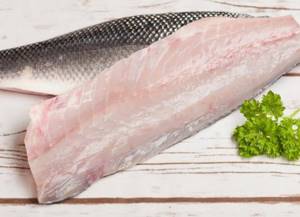
Sea bass meat contains virtually no carbohydrates, and the amount of fat in its composition is extremely low. But it contains a lot of protein (about 18 mcg per 100 g of product). Among the microelements, the following substances are distinguished, presented in the largest quantities:
- A huge amount of phosphorus, thanks to which brain cells and the nervous system are formed. The lack of this microelement leads to nervous exhaustion, loss of concentration and metabolic disorders.
- Iodine regulates the functioning of the thyroid gland and strengthens the immune system.
- Iron is involved in the process of hematopoiesis.
- Zinc has a beneficial effect on the genitourinary system of both men and women.
- Thanks to potassium, muscles are strengthened, and calcium is involved in the creation of bone mass.
Other microelements are also present in relatively small quantities: cobalt, chlorine, copper and sulfur. The calorie content of meat is just over 130 kilocalories per 100 g of product. It is noteworthy that when smoking, the calorie content is reduced by 50 kilocalories.
Among the vitamins, the largest amount belongs to vitamin A, group B, E and PP. The presence of omega-3 polyunsaturated acid in fish meat is also important. It rejuvenates the body and participates in many metabolic processes. It has been observed that people who frequently eat sea bass have healthy hair, smooth skin and healthy blood vessels. They practically do not suffer from high blood pressure and have stable mental health.
What parasites live in sea bass
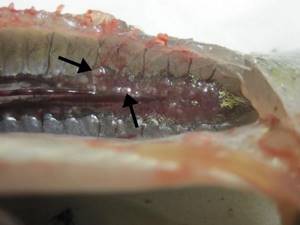
According to statistics, about 15 million people in different countries get sick every year because of the meat of this fish. Most of the parasites in sea bass are not harmful to humans. Such harmless creatures include the following helminths:
- Thin, thread-like Pharionis cystidicola.
- In the liver of the fish you can find a white parasite in the shape of a ball.
Dangerous parasites of sea bass for humans include Diphyllobothrium latum (wide tapeworm). If the disease is ignored, the parasite grows up to fifty meters in length.
Slightly smaller in size is Diffylbothrium dendricitum, which mainly lives in fresh water bodies.
The danger of parasites is that they can live not only in the liver and intestines, but even in the brain and eyes. Unfortunately, they are not so easy to detect, and their actions are extremely aggressive and lead to irreversible consequences. Particularly dangerous is the sudden proliferation of helminths. This happens most often as a result of weakened immunity. Sometimes people don't know which parasites in sea bass are dangerous and which are practically harmless.
Parasites are so small that they are extremely difficult to detect. Today tests are not available to everyone. Their price is extremely high, and the location is often limited to a few large cities.
Parasites in sea bass: photos under the skin and on the body
A person can live in many varieties of parasites, including opisthorchid.
These are flukes (flatworms) that enter the body after eating infected fish. Most often this is sea bass, the parasites under the skin of which can live for a long time. But what are the causes of opisthorchiasis and how to fight it?
Reasons for the development of the disease
The danger of helminthiasis caused by opisthorchiasis is that it affects the bile ducts and liver of the host. The disease is caused by two types of trematodes: Opisthorchis felineus and viverrini. Their structure and development cycle are almost identical.
The first type of trematodes is more common in the CIS countries (Russian Federation - 70%, Belarus - 3-5%, Ukraine and Kazakhstan - 7-10%), and the second is found in Southeast Asia.
Opisthorchid was first discovered in the human liver in 1891 by Professor K.N. Vinogradov, who named the parasites the Siberian fluke.
On the path of their development, flukes change host three times:
- shellfish;
- fish (roach, perch, ide, bream);
- mammals (humans, dogs, foxes, cats, sables) that eat fish products.
The definitive host excretes parasite larvae and eggs along with feces. The eggs then penetrate the water, where they are swallowed by shellfish. In their body they actively develop, turning into miracidium, sporocyst, redia and tailed cercaria larva.
The latter comes out of the mollusk into the water, and then attaches to the body of the fish, penetrating into its muscle and connective tissues. The cercaria then initiates and becomes a matacircaria. The development of opisthorchiasis in fish lasts about 6 weeks, after which the larvae become infectious, which allows them to infect humans with opisthorchiasis.
Attention! Opisthorchids can live up to 25 years in the body of the main host!
Mammal nesting occurs when an animal or person eats a contaminated fish product that has not been cooked. In the intestine of the host, the shell of the larvae is split, which allows the metacercariae to enter the bile ducts.
The metacercariae turns into a mature opisthorchis, which can lay eggs, after 30 days. The life cycle of the parasite is 4-4.5 months. The scale of infestation can vary - from a few individuals to 10 thousand worms. But why is fluke dangerous for humans and how to prevent its development?
What harm do opisthorchids cause to humans?
Flukes choose the liver, pancreas and gall bladder as their habitat. Using suction cups, parasites stick to the walls of organs, damaging them. This provokes an inflammatory process and disrupts the functioning of the urinary organs.
When opisthorchiasis occurs, a person experiences such unpleasant symptoms as:
- nausea;
- discomfort in the right hypochondrium;
- bowel dysfunction;
- lack of appetite;
- heat;
- jaundice may develop.
Flukes also have toxic effects on the host's body. Therefore, he experiences muscle pain and headaches, gets tired quickly and his heart rate increases.
Allergic reactions also appear and the immune system is weakened.
Long-term parasitism of flatworms is dangerous because they contribute to chronic inflammation of the pancreas and liver , which causes the organs to become clogged and destroyed.
chronic hepatitis occurs , which leads to subsequent proliferation of connective tissue. cirrhosis appears - a disease that has no cure.
fibrosis forms in the bile ducts . The cells are at the stage of proliferation, which ends in liver cancer. That is why opisthorchids are considered oncogenic parasites.
Also, with opisthorchiasis, various infections often occur, which can lead to purulent cholangitis .
In order not to become infected with helminthiasis, you need to prevent its development. Therefore, it is important to know which worms affect marine fish.
What parasites are found in perch?
There is an opinion that helminths can only be found in freshwater fish. But this is not true, because marine species can also be infected with worms. For example, there are parasites in sea bass, photos of which can be seen below.
Certain types of parasites that live on fish may not be dangerous to humans. Most often it is a large and long helminth called ligula.
Also found in perch:
- schistocephamos;
- Cystidicola pharyonis;
- Trienophorus nodulosus;
- phylometra.
Dangerous pathogenic microorganisms include Iffilobothrium dendriticum and Diphyllobotrimum latum.
Opisthorchiasis is often found in cyprinids. Red and sea fish cannot be infected with opisthorchid . But flukes often infect roach, crucian carp, bream, carp, and so on.
Parasites of sea bass - Sfirion lumpi. These are crustaceans with a long and narrow neck, a wide head and a flat body. Their length is from 4 to 7 cm. Young individuals are white, and old ones are brown.
Reference : Sphyrion is found in beaked, golden and small sea bass.
Only the head and neck of the crustacean penetrate the muscle tissue of the fish. Ulcers form in the implantation zone. If they are large, then they contain sticky exudate.
Parasites on sea bass, the photo of which is shown below, are isolated from the host by forming a connective tissue capsule that may protrude slightly above the ulcer.
There may be more than one parasite in sea bass. Thus, the number of crustaceans that infect fish can reach 12 pieces. Moreover, even after the death of the parasitic microorganism, the capsule remains in the body of the perch.
Prevention of opisthorchiasis
Preventive measures in the fight against opisthorchiasis are aimed at proper processing of seafood products. After all, the highest risk of infection is among people who eat raw or frozen fish.
Therefore, the disease is often diagnosed among lovers of sushi and rolls, housewives and cooks who try raw minced meat, and residents of the North whose national dish is struganina (raw fish slices).
To prevent the appearance of opisthorchiasis, it is necessary to properly process the fish.
There are various ways to prepare and store fish. But which of them allows you to prevent the development of opisthorchiasis?
Freezing
The fluke is resistant to low temperatures. Therefore, metacercariae can die 15 days after freezing the product if the temperature is maintained (-12 and below) and provided that the entire product is evenly frozen.
However, it is not advisable to quickly freeze an infected perch at low temperatures, because there is a risk that the fluke will survive even after thawing.
Reference : slave infected with flatworms stored in the refrigerator can be a source of infestation for 30 days.
Salting and drying
In order for the parasite larvae to be completely destroyed, salting must be done in a 20% saline solution. For disinfection, the product must be in liquid for at least one week. Moreover, small batches are salted faster, which significantly reduces the risk of possible infection with the Siberian fluke.
If the fish is to be dried, it must first be salted for at least 14 days in a saturated salt solution. If the duration of salting is reduced, then the drying time should be increased to 21 days.
Heat treatment
The best way to disinfect fish is heat treatment. But this matter also has its own nuances. To fry or boil the product, you must first cut it into small pieces. To prevent infection, seafood should be cooked for 20-15 minutes at a temperature of 100 degrees. It is advisable to cook whole fish or large pieces for at least 40 minutes.
Baking in the oven should last about 60 minutes. It is better to use hot smoking, lasting 2 hours at a temperature of 80 degrees. If you are planning a cold method of processing fish with smoke, then it must first be salted, as when drying.
To protect yourself from purchasing a low-quality product, you need to buy fish that has a veterinary certificate.
In addition to following all cooking rules, it is important to know how to cut fish. So, for such a process it is necessary to allocate a separate knife, board and dishes .
It is also equally important to heat-treat fish for animal feed. After all, if a pet eats an infected product, it will become a carrier of helminthiasis. And the parasite larvae will be released along with feces into the environment, which will allow the flatworms to continue their life cycle.
Conclusion
Significant preventive methods of opisthorchiasis are sanitary and educational measures. It is equally important to carry out timely treatment of invasive animals and people, as well as conduct epidemiological control of seas, lakes, rivers and reservoirs.
Source: https://101parazit.com/gelminty/ploskie-chervi/opistorhoz/parazity-u-morskogo-okunya.html
How to determine the presence of parasites
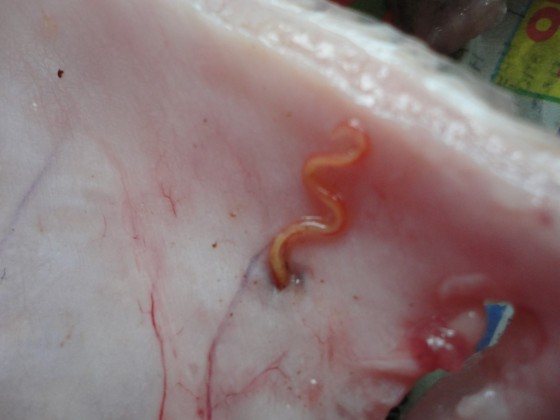
There are some characteristic signs for this:
- For some unknown reason, a person develops a runny nose that does not go away within several days.
- Watery eyes indicate the possible presence of parasites obtained from sea bass.
- Joint pain is also a signal of the possible appearance of helminths.
- Stomach upset, diarrhea, constipation, or strange colored or smelling stool may indicate worms in the stomach.
- Regular sore throats and colds.
- Poor appetite and nervousness along with bags under the eyes are also very unfavorable symptoms.
People who have foreign elements in their bodies feel tired and have frequent headaches. Their performance is reduced, which often results in nervousness and irritability.
How to identify sick fish
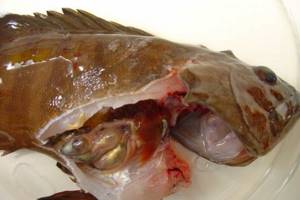
As a rule, infected fish has an unpleasant odor, which manifests itself when preparing the broth. She should not have dry mucus or a swollen abdomen. Cloudy eyes also indicate that the fish is sick in some way. When cutting up a carcass, heavy bleeding sometimes begins. This phenomenon should not occur in healthy fish. Faded gills and uneven skin also indicate the presence of the disease.
In nature, such fish are delayed in development and often remain small. Her fertility noticeably decreases, and sometimes her ability to reproduce completely ceases.
Roundworms
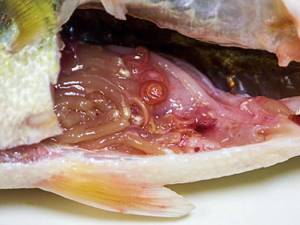
Otherwise they are called nematodes. Some of these parasites living in sea bass are practically harmless to the human body. However, there are also those that are extremely dangerous. They cause a disease called anisakiasis. This serious illness is usually very acute. The patient's gastric patency is impaired, fever appears, and after a while - inflammation of the abdominal cavity. The patient requires urgent hospitalization, as a result of which the affected area is reduced. The patient develops ulcers and numerous tumors in the stomach. An infected person constantly vomits and also experiences sharp pain in the abdomen.
To prevent the appearance of parasites in sea bass, it is recommended not to eat fresh fish, but to purchase exclusively frozen products. After all, it is deep freezing for sixty hours that can neutralize the product.
If there are black dots on the body of the perch, then most likely the fish has been affected by flukes. After entering the human stomach, they accumulate in the small intestine and, as a result of the inflammatory process, can lead to necrosis.
Parasites in marine fish
Fish infected with helminths is not uncommon. Many people are unaware of the richness of the animal world until they buy a product with creatures of unknown origin. There is an immediate desire to throw away the fish, but not all helminths can harm human health. Infestation is caused by the following classes of parasites:
- Nematodes are roundworms. Representatives of this genus are red in color. Scientific photographs show that the length of the helminth can reach 10 cm. Philometra fasciati, Philometra lethrini settle on cyprinids and are not dangerous to humans. Parasites of the species Contracaecum osculatum, Pseudoterranova decipiens cause a dangerous disease in humans - anisakiasis.
- Cestodes are tapeworms. Ligula intestinalis uses fish as an intermediate host. With its impressive body, the ligula causes harm to the internal organs of the animal. The definitive host of this parasite is herbivorous birds. Helminths of the genus Diphyllobothrium negatively affect human health and can reach 10 m in length.
- Trematodes. Posthodiplostomum cuticola causes postodiplostomosis. The disease appears as black spots throughout the body of freshwater fish. Dangerous parasites for humans are Clonorchis sinensis, Opisthorchis spp, helminths of the Heterophyidae family. If large numbers of worms accumulate in the small intestine, inflammation and necrosis may occur.
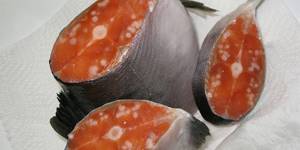
Crustacean parasites
The most prominent representative of parasites under the skin in sea bass is Sphyrion lumpi. It affects both freshwater and sea bass. It appears under the skin of the fish, but sometimes half of the parasite’s body remains outside. In order to get rid of it, you should thoroughly heat treat the meat using salt and a sufficient amount of spices. A healthy fish should have a strong, elastic body with a good layer of fat. Often during the preparation of fish soup, dark pieces of parasites are observed floating on the surface.
Is Sfirion Lumpi dangerous for humans?
The appearance of an infected animal may be a reason to avoid preparing a fish dish, but Sphyrion lumpi does not pose a threat to human health. Before sale, fish are subject to sanitary inspection. If there are single lesions, it is frozen and put on sale, after removing the crustaceans. If helminths are found on internal organs, the fish is processed to obtain bone meal. At home, you should carefully examine the carcasses, remove hard capsules, and wash and heat treat the rest of the meat.
- Polyester - what kind of fabric is it?
- Is it possible to get pregnant before your period?
- Zucchini pancakes with minced meat
Harm from opisthorchiasis
They are very often associated with the occurrence of liver cancer. Once inside, they attach their suckers to human organs and feed at their expense. The most common target for injury is the liver. A person experiences diarrhea and nausea. Body temperature can be either slightly elevated or quite high. Also, with advanced disease, yellowness of the skin and eyes may appear.
The patient's immunity is noticeably weakened due to exposure to a rather strong toxin. Cirrhosis of the liver and inflammation of the pancreas gradually develop.
What harm do opisthorchids cause to humans?
Flukes choose the liver, pancreas and gall bladder as their habitat. Using suction cups, parasites stick to the walls of organs, damaging them. This provokes an inflammatory process and disrupts the functioning of the urinary organs.
When opisthorchiasis occurs, a person experiences such unpleasant symptoms as:
- nausea;
- discomfort in the right hypochondrium;
- bowel dysfunction;
- lack of appetite;
- heat;
- jaundice may develop.
Flukes also have toxic effects on the host's body. Therefore, he experiences muscle pain and headaches, gets tired quickly and his heart rate increases.
Allergic reactions also appear and the immune system is weakened.
Long-term parasitism of flatworms is dangerous because they contribute to chronic inflammation of the pancreas and liver , which causes the organs to become clogged and destroyed.
chronic hepatitis occurs , which leads to subsequent proliferation of connective tissue. cirrhosis appears - a disease that has no cure.
fibrosis forms in the bile ducts . The cells are at the stage of proliferation, which ends in liver cancer. That is why opisthorchids are considered oncogenic parasites.
Also, with opisthorchiasis, various infections often occur, which can lead to purulent cholangitis .
In order not to become infected with helminthiasis, you need to prevent its development. Therefore, it is important to know which worms affect marine fish.
Prevention rules
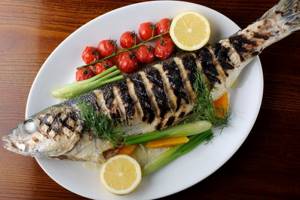
Parasites in sea bass die during long-term freezing of products, as well as during salting and drying. In the case of salting, the fish must be in brine for at least seven days, and before drying the number of days increases to two weeks. In the case of smoking, the fish is also kept in brine for as long as possible, and only then smoked.
When heat treated, the baking process should last at least two hours. Fry the meat until a brown crust forms, and the pieces are cut as thin as possible. It is extremely important to use separate knives and cutting boards for cutting fish. After work, all tools are disinfected with a soap solution.

